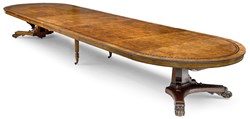As Chinese art and antiques objects get caught in the US-China trade war, importing them into the United States has been headline news of late.
The Washington, DC lawyer who found himself in the eye of that storm is Peter Tompa, a specialist in cultural property law at Bailey & Ehrenberg. He is also a director of the Global Heritage Alliance (GHA), a lobbying group for collectors, museums and the trade in archaeological and ethnological objects.
It was in the latter capacity that Tompa became the Chinese art world’s advocate, starting in June 2018, attempting to persuade US trade officials to exclude Chinese art from Trump’s tariffs.
“The strongest argument we put forward is that this tariff damages the art market in every country exporting to the US except China, because the Chinese have such strict export controls on art leaving their own country,” Tompa says. Tompa and the GHA managed to get Chinese art struck off the first list, in September 2018, but was “surprised and disappointed to see it reappearing in time for the imposition of 15% import tax earlier this month”.
In his spare time, Tompa is a collector himself. And in collecting ancient coins, some acquired from UK auctioneers such as DNW and Spink, Tompa is only too aware of the legal hurdles that buyers face in importing and exporting to the US.
Here, Tompa picks three key collecting areas and the US regulations that buyers and suppliers need to be aware of.
1. Chinese art
State of play: since September 1, anyone importing Chinese-made art, antiques and antiquities into the US from any location in the world must pay a 15% tariff on each item. “The tariff is a disincentive for consignors and dealers outside the US to export Chinese art to the US,” Tompa says “They’ll have to pay the tariff up front, which is a risk. What if the item doesn’t sell?”
Future direction: “Consignors of Chinese art wishing to sell in the US could choose to wait it out, as this trade war isn’t going to go on forever.”
2. Cultural goods including antiquities
State of play: Import into the US of specific cultural goods and antiquities is restricted unless accompanied by an export permit issued by the country where such items were likely found, or proof that they left before the effective date of restrictions.
Those import controls are on objects from 20 countries – mostly in Latin America (pre-Columbian archaeological objects), the Middle East and Europe.
Future direction: “US customs is getting much more cognisant of this field and are building a team of experts and an extensive database of art imports. The best advice is to be meticulous with pre-export paperwork – listing country of manufacture, an accurate description of the goods with the right monetary value. If you get this wrong, customs can seize your objects and repatriate them.”
3. Native American objects and art
State of play: It is currently legal to sell and buy Native American cultural objects, and to export them, as long as some criteria are met. But a major change is on the way: a complete ban on the export of certain Native American objects is likely to come if the STOP (Safeguard Tribal Objects of Patrimony) bill becomes law.
Future direction: “This is a complicated collecting area and an export ban is likely,” Tompa says. “Right now, questions asked include, was the object found on public (federal) or private land, taken from a grave, or is it possible that it was once stolen? Otherwise, Native American objects can be traded.
“There are no controls on importing Native American artefacts into the US. There are issues, however, with sacred items that can be attributed to a certain tribe, which might have the right to its repatriation. A court would have to adjudicate on that.” n















